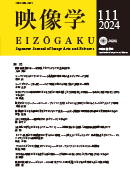Current issue
Displaying 1-15 of 15 articles from this issue
- |<
- <
- 1
- >
- >|
ARTICLES
-
2024 Volume 111 Pages 5-27
Published: February 25, 2024
Released on J-STAGE: March 25, 2024
Download PDF (979K) -
2024 Volume 111 Pages 28-46
Published: February 25, 2024
Released on J-STAGE: March 25, 2024
Download PDF (676K) -
2024 Volume 111 Pages 47-71
Published: February 25, 2024
Released on J-STAGE: March 25, 2024
Download PDF (1246K) -
2024 Volume 111 Pages 72-94
Published: February 25, 2024
Released on J-STAGE: March 25, 2024
Download PDF (1193K) -
2024 Volume 111 Pages 95-115
Published: February 25, 2024
Released on J-STAGE: March 25, 2024
Download PDF (726K) -
2024 Volume 111 Pages 116-135
Published: February 25, 2024
Released on J-STAGE: March 25, 2024
Download PDF (1509K) -
2024 Volume 111 Pages 136-156
Published: February 25, 2024
Released on J-STAGE: March 25, 2024
Download PDF (731K) -
2024 Volume 111 Pages 157-176
Published: February 25, 2024
Released on J-STAGE: March 25, 2024
Download PDF (755K) -
2024 Volume 111 Pages 177-197
Published: February 25, 2024
Released on J-STAGE: March 25, 2024
Download PDF (753K) -
2024 Volume 111 Pages 198-217
Published: February 25, 2024
Released on J-STAGE: March 25, 2024
Download PDF (591K) -
2024 Volume 111 Pages 218-237
Published: February 25, 2024
Released on J-STAGE: March 25, 2024
Download PDF (772K) -
2024 Volume 111 Pages 238-259
Published: February 25, 2024
Released on J-STAGE: March 25, 2024
Download PDF (837K)
REPORT
-
2024 Volume 111 Pages 260-269
Published: February 25, 2024
Released on J-STAGE: March 25, 2024
Download PDF (456K)
REVIEWS
-
2024 Volume 111 Pages 270-273
Published: February 25, 2024
Released on J-STAGE: March 25, 2024
Download PDF (446K) -
2024 Volume 111 Pages 274-277
Published: February 25, 2024
Released on J-STAGE: March 25, 2024
Download PDF (347K)
- |<
- <
- 1
- >
- >|
